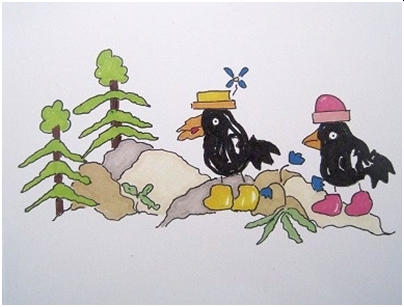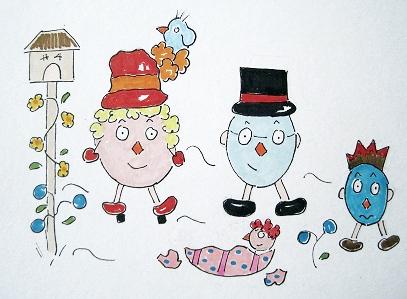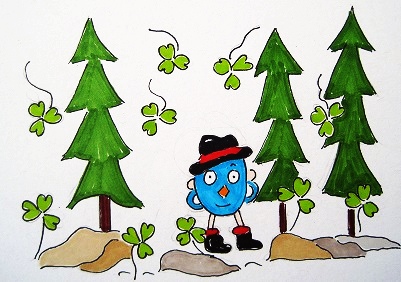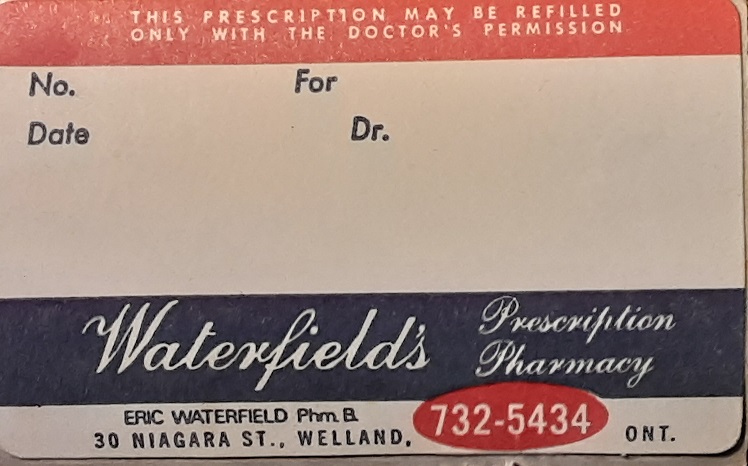 Its August now with less daylight each day
Its August now with less daylight each day
And shortly for this good weather we’ll really pay
We’re in the eighth month the year is going fast
Yes it won’t be long until its all gone past
It was named after Augustus Caesar so what can we do
May no one ever say lets change that too
Leo is the Zodiac sign for some August folk
But most people feel the sign is a big joke
The Civic holiday is on August first this year
So it won’t be long the winter will be here
Blackberry blossoms I’ve seen are heavy once again
Which means lots of snow oh what a pain
For every fog in August in the winter there’s a snowy day
Lets all get out and try to keep it blown away
August brings the best bounty of the season
And to prepare for winter we have a good reason
Canning season is here lets can tomatoes and beans
Cucumbers and beets plus other vegetables we’ve seen
Harvest vegetables and fruit then put them away
Then in the winter no food I have no one can say
Two birth flowers of August are gladiolus and poppy
But they are soon gone and for awhile them we don’t see
Its almost over the season for light clothes
And just around the bend we’ll wear things unlike those
The birthstones of August are sardonyx spinel and peridot
For those with birthdays then if they know it or not
If it rains in August it rains honey and wine
Although that’s something I’ve never seen at any time
On August eleventh the sturgeon moon reaches its peak
It’s the last super moon of the year that I do speak
Called the sturgeon moon as they were caught in the great lakes
While some in Lake Champlain people also did take
Remember summer is gone there are cooler days ahead
So there may be mornings we wish to stay in bed
Winston E. Ralph
by Sheila Hird
[Welland Tribune]
In 1812 residents of Niagara were busy clearing land and settling into their new homesteads. The last thing on their mind was war.
Bur James Madison, the president of the States, quickly changed that when, to retaliate against Britain for blocking the States, he declared war on Canada on June 18, 1812.
The Americans underestimated Canada’s loyalty to Britain and thought the war would be a short one. General Widgery declared he would conquer Upper Canada in six weeks. Mr. Calhoun thought he was being ridiculous and that it would take no longer than a month. Henry Clay firmly stated he would never settle for a peace treaty that did not cede Canada to the States.
Much to everybody’s surprise the war dragged on for two and a half years and did not conclude as the Americans expected.
The war was mainly fought in battlefields in the Niagara peninsula, Queenston, Fort George, Stoney Creek, Beaver Dams and Lundy’s Lane are a few names among many.
QUEENSTON
The men from the Niagara region fought in the first regiment of the Lincoln Militia under the command of Captain James Servos. Most of these men were farmers who had fled from the States as United Empire Loyalists.
When General Brock arrived in the peninsula he positioned the majority of troops in the town of Queenston and the remaining troops on the summit of Queenston Heights.
The townspeople prepared for an American attack by burying their valuables or by taking them to friends who did not live in the battle zone.
In the early morning of October 13, 1812, the American forces gathered at Lewiston. The sound of cannon fire woke General Brock from his sleep. Captain john Ball, who had kept watch throughout the night, poured a volley on the approaching American boats. In return the enemy poured a heavy shot from Fort Niagara that set many of the houses and buildings on fire.
Although Brock and his aide-de-camp, McDonell, were quickly on the scene, the enemy beat them to the summit of the heights.
Brock, determined to take the heights, charged the enemy’s troop of 4,000 men with a troop times smaller. After uttering his last order “Push on York Volunteers” Brock was hit in the chest. Seconds later McDonell was also struck. Brock died that same day and McDonell the next.
Despite the causalities on the British side, the charge had succeeded in throwing the American troops into a state of confusion. When General Sheaffe arrived with the reinforcement troops the battle was quickly concluded. The Americans raised the white flag while more than 900 of their men were taken prisoner and sent to Queenston.
FORT GEORGE
The defeat of Queenston did not end the American offensive.
On April 27, 1813, General Dearbon and his troops settled into the undefended town of York. After setting fire to the government buildings, many private buildings, the library and the shipyard, the Americans evacuated the town
On May 27, the American troops, numbering about 6,000, arrived at Crook’s farm hidden from the British by a blanket of fog over the lake.
They opened fire on the British troops who numbered less than 1,500. General Vincent repulsed the enemy three times as they attempted to land at Fort George but he soon ran short of men and ammunition.
After spiking all the guns of the fort and destroying all the military paper, General Vincent ordered a retreat. After evacuating the fort, the troops took the River Road to Queenston and then marched on to Burlington Heights, leaving the Americans in charge of the peninsula.
STONEY CREEK
A few days after the British troops arrived at Burlington Heights, the Americans, under the command of Generals Winder and Chandler, set out in pursue them.
On June 6, the American troops stopped at Stoney Creek to spend the night. Vincent, eager to learn the strength of these troops, sent several of his soldiers dressed as civilians to sell butter and cheese to the enemy.
Vincent and his aides, Harvey and Murray, resolved that the only way to take such a large force was to attack by night.
Colonel Harvey with a small force, attacked the American camp before dawn. They were followed by several Indian troops and the rest of the militia numbering less than 800 men.
Although the Americans had almost four times as many men, they were soundly defeated. Generals Winder and Chandler were taken prisoner. The guns and supplies were confiscated and the whole camp gutted. The British were surprised that it took the Americans four days to reach Stoney Creek but only one day to return. The British troops were now able to advance to within four miles of Newark.
BEAVERDAMS
As the British retreated to Burlington Heights before the Stoney Creek battle, Vincent ordered all arms and ammunition be stored in John DeCew’s farm (near Beaverdams) in Thorold township.
Lieutenant Fitzgibbon and his troop of Green Tigers known as “Fitzgibbon’s Green Uns” guarded this depot. It was not long before the Americans received wind of this arms cache and busied themselves planning for a surprise attack.
The events that followed tell the famous story of Laura Secord.
The American soldiers preparing for the attack were billeting at the home of Peter and Laura Secord. One evening Laura overheard plans for an attack on the DeCew farm and made up her mind to embark on a twenty mile journey to warn Fitzgibbon.
One tale tells how Laura set out the following morning with a milk bucket over her arm and a cow by her side. Although this story may have some truth in it, it is generally believed that Laura used the excuse of her ailing brother to slip past the guards.
Fearing she might meet General Boestler’s men on the main road, Laura travelled by the Swamp Road. While hurrying along the road to avoid meeting the wolves and rattlesnakes that inhabited the area, Laura lost a shoe.
The second shoe was lost as Laura made a dangerous crossing of the Twelve Mile River. The flooding river had swept away the bridge and Laura was forced to cross the raging waters by crawling along the trunk of a fallen tree. Despite all these difficulties Laura arrived at the DeCew farm and gave her message to Fitzgibbon.
Preparations for an attack were begun immediately. The supplies were sunk in the DeCew pond and scouts were sent to find the enemy. A party of Indians under the command of Ducharme were then sent out to ambush the Americans.
As Boestler’s men marched along the Mountain Road past the farmhouses of the Browns, the Hanslers, the Metlers and the Hoovers, the Indians lay in the thickets waiting. They waited until the troops were past them before they opened fire on the rear and on the flanks.
At the point Fitzgibbon and his men appeared to reinforce the Indians. After a three hour battle the Americans surrendered. Thanks to Laura Secord the British won the day and the Battle of Beaverdams proved to be the turning point in the war.
NEWARK
As winter drew n near, the Americans occupying Newark realized they had to retreat before the ice and snow closed up the river.
On October 14, 1813, two companies of soldiers left Fort George at 1 p.m., armed with torches and lanterns.
They gave the 400 residents of Newark one hour’s warning before setting the town to flames. It took the soldiers less than half an hour to set the whole town ablaze. By the time the British arrived on the scene, the enemy had escaped and the only building left standing was Butler’s Barracks.
After the British retaliated, neither the Americans nor the British were eager to continue the war. Lengthily negotiations resulted n in a peace settlement in which both sides accepted the status quo. The treaty was signed in Ghent on Dec. 24, 1814.

July folks is now the seventh month of the year
And before we know it the cold weather will be here
Vacations will be planned but folks won’t go too far
Because now it’s too expensive to drive a car
Yes road trips will be shorter that I can see
Some will do shorter ones and less including me
Others may take a tent or trailer out and camp
While others in Algonquin Park take a long tramp
It’s now time to lay on the beach there in the sun
But be careful of sunburn as they aren’t any fun
Golfing fishing and swimming are things some may do
So will they be enjoyed by all including me and you
Some may enjoy paddling a kayak down a river
And there’ll be campfires to make heat that’s a given
Marshmallows will be roasted there on a fire
Let no one get upset and raising his ire
Farmers harvest the wheat as the daylight gets less
May the crop be the best one to that I’ll say yes
Fireworks will happen on July 1st Canada’s birthday
But we’re not the Canada of 67 that I can say
July 12th is a day that was celebrated everywhere
Like everything else it’s gone or people don’t care
On July 28-31 it’s the Gem and Mineral show the gemboree
It’s too congested with people so it’s not for me
People are out looking for rocks yes all around
Yes we all know for sure they’ll be found
The U.S. celebrate Independence Day on the fourth of July
They don’t say U.S. Day but here it’s Canada not Dominion why
Some flowers of July are waterlily and larkspur
And delphiniums bloom also but winter is coming for sure
Wood needs cutting and piling in May so it will be dry
You’ll burn wet wood if you wait until the snow flies
Winston E. Ralph, 2022

At the end of June school will be out
Its time to enjoy summer the children will shout
Folks will go to the cottage on congested roads
Taking a boat or some other big load
Farmers will be in the fields baling hay
But years ago it was done a different way
Strawberries will be picked and sold to folks
Some will be eaten or made into jam its not a joke
Picnics will be had to celebrate some reason
Yes summer is the time for them the right season
Weeds must be pulled from the garden from time to time
And the grass will grow longer it you’ll find
Others will go swimming out there in the lake
Some will fish and boat and from work take a break
Folks may hike while others will water ski
But its over sixty years since being done by me
Some will camp in a tent others a trailer too
A canoe will paddle along and some sailing do
Butterflies are out and bees are buzzing around
And being outside most folks are happy to be found
Some months of thirty days are Sept. April June and Nov.
So enjoy the weather as its colder we remember
The summer solstice falls on the twenty-first of June
But time will slip away and be colder very soon
Those born in June are under the Cancer sign
So may no one get that disease at any time
The main flowers of June are Honeysuckle and Rose
Yes many flowers will bloom each day including those
The months name is from Juno the wife of Jupiter
So I hope like me you’ve learned a little more
We have the most daylight on June 21st in this country
While down south its the longest night that we can see
Winston E. Ralph
Bancroft, Ontario
By Robert J. Foley
[Date Unknown]
Visitors to Niagara Falls, who happen, by chance or design, to drive out Lundy’s Lane along Highway 20 and cross the canal bridge at Allanburg are in for a treat. Astride the hills which dominate the landscape is the village of Fonthill, sitting like a crown on the brow of the Peninsula. Fonthill forms the hub of what is now the town of Pelham.
The first settlers in the area were refugees from the American Colonies who began arriving as the revolutionary war was in full swing. Major David Secord, brother-in-law of the famous Laura Secord, settled on three hundred acres in the area around 1781. By 1783 there were 46 families in the township which was named Pelham by the Lieutenant-Governor, John Graves Simcoe. David Secord became the Justice of the Peace and a small community began to grow where Fonthill now stands.
Among the early arrivals was one George Hansler who settle down with his wife and daughter in 1782. He became a benefactor to the community when he donated the land for a school in 1821, which was appropriately named Hansler school. Nichols Oille settled in 1783 and built the first brick house in the township with clay from his own land.
The War of 1812, which devastated much of the Peninsula bypassed Pelham as far as material destruction went, however many of her sons served in the militia and so action in many of the battles fought in the peninsula. Despite this fact, Pelham almost became a military base. The Duke of Wellington visited the peninsula in 1825 and upon seeing the dominant position that the town held from the ridge, which now boasts the Lookout Point Golf Course, he proposed to build a fort there. It even got to the design stage before the plan was abandoned.
Pelham did not remain immune from the fortunes of war however. During the rebellion of 1837, a number of locals sided with William Lyon MacKenzie and in that year 38 men and two women were rounded up and charged with treason. The group was sentenced to death by hanging but the sentences were commuted to being transported to a penal colony in Tasmania for life. One Samuel Chandler, however, managed to escape and returned home in 1841, he packed up his family and moved south never to be heard of again.
In 1871 Pelham boasted a population of 776 with three grist mills, six saw mills and all the other amenities that made up a prosperous community in the early part of the 19th century. Many of the peninsula’s settlements underwent many name changes before they received the ones we know today and this one was no exception. It was first known as Riceville after one of its early justices of the peace. It was called Osbournes’s Corners, for Osbournes’s Inn for a short time after 1842 but then was again changed, this time to Temperanceville, probably to the chagrin of Mr. Osbourne the inn keeper. In 1850 it finally received a proper name and became Fonthill after Fonthill Abbey in England.
The mid-19th century were momentous times for Pelham. In 1851 Fonthill, because it held the local registry office was in the running for the new Welland County seat along with Port Robinson, Cook’s Mills and Merrittsville. The competition was hot and heavy and in 1854 Merrittsville (Welland) won out. Looking at the region today we might think Welland was the obvious choice, however in 1850 the population of Welland was 750, while Pelham could muster a count of 2,253 souls.
Today Pelham, containing some of the most beautiful landscape in the peninsula, consists of the villages of Ridgeville, North Pelham, Effingham, Fenwick and the surrounding agricultural lands.
It is, indeed, the jewel in the crown.

Our snow is gone as its now the month of May
Yes better weather we’ll get that I can say
Its time to garden and till up the soil
Then at harvest time we’re thankful for our toil
I’m looking for vegetables as prices are high
So in the store their produce I can go on by
Grass is greening up so lets get the mower out
No need to leave it until someone does shout
Another holiday thats coming on the 23rd of May
Is one that may be dropped yes Victoria Day
The cottages then will be opened for the season
So folks can relax and unwind the main reason
Bears are out of their dens after a long hibernation
Looking for food so lets give them no aggravation
Farmers are happy to till their land once again
Yes I pray they’ll have sunshine and lots of rain
Temperatures are warmer so outside chores are done
Like wood cutting and others under the warm sun
Some may take a trip to museums or other place
And seeing things from yester year puts a smile on our face
Apple cherry peach trees are in blossom again this year
So in the fall a good crop we should have here
The tulip pansies etc are once again in full bloom
The trilliums are out also but for others it maybe in June
Lilacs are blooming now but only for a little while
And the lilies and daffodils to our face brings a smile
The lakes are warming up so have a swim right away
As it won’t be long until they’re cooling every day
After all the cold weather I look forward to heat
Yes for a few months the cold weather we have it beat.
Winston E. Ralph
Bancroft, ON

Easter is late coming in April this year
And for good weather don’t bother to cheer
Children carry a basket of paper or straw
Yes the crowd may be bigger than we ever saw
They’ll look for Easter eggs hidden in many places
Upon finding them a smile will brighten their faces
The Easter egg hunt is for what the children await
Yes most are ready to start without being late
Some eggs are eaten and others are decorated too
In different designs and colors like red green and blue
The Easter bunny looks for carrots and other things
So he can show his friends that he is still king
Flowers are starting to come but not outside for a while
And to see lilies and other flowers they’ll give us a smile
Daffodils are coming and soon will be in full bloom
But for other flowers we must wait until at least June
No need to get excited for spring its not here yet
As we wait until early June then it good weather you bet
Some folks may wear a lovely Easter bonnet
Yes they sure are nice with all the frills upon it
In the warmer areas they’ll have an Easter parade
But here to watch we stay in the sun not the shade
Good Friday is the start of our Holy celebration
As Christs resurrection is celebrated across the nation
He wore a crown of thorns as he went to Calvary
But the sins he paid for belong to you and me
He rose from the grave as he said he would do
And if his blood covers our sins we will too
Remember summer is short and soon it will be fall
So I just wish to say Happy Easter to you all.
Winston E. Ralph
Bancroft, ON

People can go and look the land right over
Now with all the snow there’s no four leaf clover
Do the Irish have luck no more so than other folk
And like the rest of us to win is a big joke
There’s a rainbow were told just hanging over the hill
But to find it you’ll have trouble not a big thrill
Its called the Emerald Isle as things are so green
Yes its a country by me that may never be seen
To increase our luck we are to touch the Blarney Stone
Then later we haven’t any luck were not alone
Their green clothing they wear can be worn by anyone
At home or at a party when they are having fun
People will attend parties singing songs out of key
Even though I had Irish ancestors its nothing to me
Drowning the shamrock is a custom from the Emerald Isle
Its put in a drink then its drunk with a big smile
Then swallowed or for good luck tossed over the shoulder
But you may as well toss a big Irish boulder
The unicorn and others may be prancing about
While the leprechaun will be singing loudly right out
On March the 20th spring does officially begin
And us folks in Canada for a while winter well be in
The weather can be snowy and ever so cold
Then warmer the next day with no coat we hold
Freezing at night feeling winter will always be here
As we build fires and the stove we always stay near
Animals awaken and come out of hibernation
Looking for food wherever they can across this nation
And with the change of seasons older folks pass on
Even though for a while we wish they wouldn’t be gone.
Winston E. Ralph
Bancroft, ON
[Article - submitted by Karen and Donald Young, daughter and son-in-law of Eric Waterfield.
 Eric Waterfield was born in Woodstock. He graduated from the Pharmacy program at the University of Toronto in 1941. He trained as an officer for the Canadian army and was stationed in England, but never saw active duty.
Eric Waterfield was born in Woodstock. He graduated from the Pharmacy program at the University of Toronto in 1941. He trained as an officer for the Canadian army and was stationed in England, but never saw active duty.
His pharmacy career began in Toronto, and then he purchased the former Wyllie Theal Drug store at 30 Niagara Street in 1951.The pharmacy name was changed to Waterfield’s Pharmacy. He put in long hours at the store including evenings. He would come home for supper and then return to the store.
In 1975, he sold the store, but continued to work for another three years at the Lewis and Krall pharmacy until 1978 when he retired.
Eric lived with his family at 131 First Avenue in Welland. He died in 1991 in his 74th year, and is buried at the Pleasantview Memorial Gardens in Fonthill with his wife Beatrice who died in 1990. Eric and Beatrice had three children, Ann, Karen and Rob.
Eric was an active golfer and a member of the Lookout Point Golf and Country Club since 1951. He was a member of the Welland Rotary Club. When Wesley United Church was established, Eric was a charter member.
By David l. Blazetich, from the files of his grandfather George “Udy” Blazetich
[Date Unknown]
In 1913, the Laughlin realty Company produced an advertisement to promote its interest in selling land in Welland. Large and obviously designed to promote the company’s expansion in Welland, the circular nevertheless contained much information of historical value and some now-rare photographs.
Under very large, major headings such as: “Why Welland Grows”, “Railroads and Banks”, and $50,000.000is being spent on the New Welland Canal and Welland Has Made Good”, the circular gave detailed information and a map outlining industries and points of interest in Welland, a city that is today making history.
It goes on to praise the “factories that have sprung up and are running where a year ago were vacant commons. New paved sidewalks have been paid out and completely built up. Main business and residence streets are paved. A street railway was absolutely needed and built in several months-now in operation. And this growth will keep on. More homes are right now needed for workmen coming to locate.”
It confidently predicted “Welland is destined to become one of Canada’s greatest industrial centres,” and “with its several railroads connecting it with cities like Buffalo, Hamilton and Toronto clustered around it-with its power at rock bottom price-its cheap natural gas-with the new $50,000,000 canal, there is absolutely nothing to hold back Welland’s growth.”
Specifically promoting the Manchester Park development, it asked: “What would it have meant to have bought several lots in Toronto a few years ago as close to Young Street as Manchester Park is to the Post Office in Welland- -10 minutes’ walk? The article said, “Many men in Welland have grown rich during the past few years” and “A lot or two bought now will double in value in a very short time. There is no safer investment. There is no safer investment. There is no better buy.”
All you needed was 10 per cent of purchase price (cash in hand). When the price was $200 per lot, $10 per month on one lot, and $5 per month on each additional one. When the price of the lot was under $200, $5 per month would carry it.
Manchester Park was touted as the “most favourably located subdivision in Welland today-adjacent to the great Empire Cotton Mills, Bemis Bay Company, Canada Forge Company, Chipman Holten Knitting Mills, Supreme heating Co., Goodwillie and Sons Canning Factory, Lambert’s Planing Mills, Duck Fabric Company and Welland Machine and Foundry.”
A detailed street map was included with a “Key to Industries.” A guide to the “points of Interest in Welland’ directed the reader to 23 highlights, from the Water Works Pumphouse to the public school to the Laughlin Realty Company Ltd. Office, the turning basin of the Welland Canal and the Temple Club.
Although the article is a blatant {and probably expensive, for its time} advertisement of the company, the information and photographs present an emerging community of 9,000 with 25 operating industries and a Dominion government-financed canal with a $50,000,000 price tag and “work…now under way.” With seven railroads, Welland was absolutely the best town for shipping conveniences in Canada.”
 Its August now with less daylight each day
Its August now with less daylight each day Subscribe..
Subscribe..





 Eric Waterfield was born in Woodstock. He graduated from the Pharmacy program at the University of Toronto in 1941. He trained as an officer for the Canadian army and was stationed in England, but never saw active duty.
Eric Waterfield was born in Woodstock. He graduated from the Pharmacy program at the University of Toronto in 1941. He trained as an officer for the Canadian army and was stationed in England, but never saw active duty.